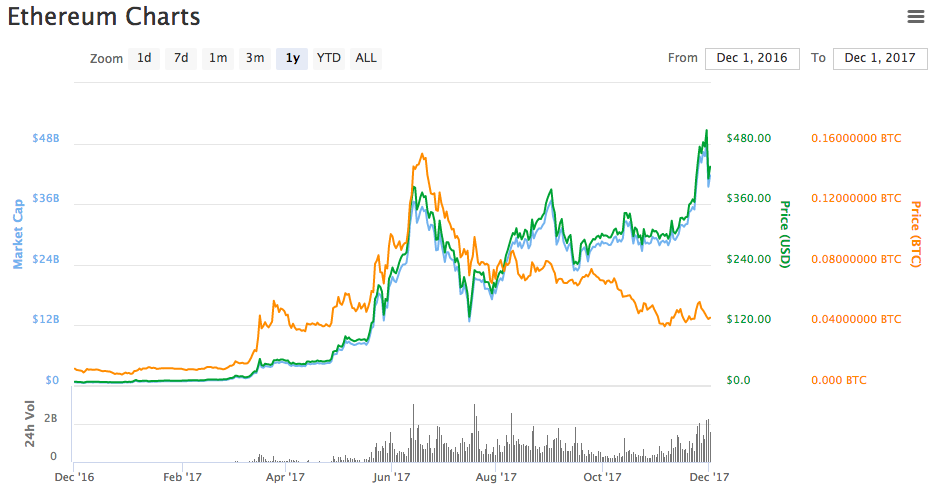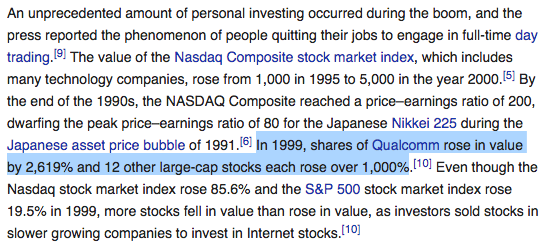Cryptocurrencies: The Next Dot-com Bubble?
Cryptocurrencies are quickly becoming one of the most talked about phenomenons of all time. Opinions vary widely, and it’s hard for even the most technical minded person to fully grasp how they work, let alone why they have value, but there’s no doubt that the concept is captivating, being described as a “brain virus” by some in Silicon Valley. And honestly, a large part of the reason it’s captivated so many is the ridiculous run-up in cryptocurrency prices, not just Bitcoin but also relative newcomers such as Ethereum, Dash, IOTA, and others. It’s a bull market unlike any other, with many cryptocurrencies gaining over 1000% in 2017 and others with even more eye-popping gains.
 Ethereum has taken it’s investors on a wild ride over the past year, going from about $8 on New Years Day 2017 up to resistance at $400 two times and then topping out at $515 going into December.
Ethereum has taken it’s investors on a wild ride over the past year, going from about $8 on New Years Day 2017 up to resistance at $400 two times and then topping out at $515 going into December.
I should disclose up front that I am invested in cryptocurrencies. I have stakes in Bitcoin, Ethereum, and others. So while I admit bias, I did want to take a look at the unprecedented and possibly warranted valuations in the cryptocurrency markets.
Previous Thoughts
Cryptocurrencies have captivated me for years now. Unfortunately I didn’t invest significantly back then and hold, which taught me a painful lesson about long term investing and patience. I first came across Bitcoin back in 2013, during a wild run-up from $15/BTC to $250/BTC, before crashing and losing about 50% of its value. It was less than a year later that I anxiously wrote an article on the Mt. Gox collapse as it happened (luckily I was using Coinbase at the time). After the Mt. Gox collapse, I was thoroughly spooked by this financial Wild West of sorts, especially after the market collapse and extended bear cycle, conceding that the idea was promising, but that Bitcoin itself was out of control volatile and a terrible investment. Boy was I wrong.
Cryptocurrencies in 2017
Much has changed since the choppy days of Mt. Gox in 2014. Bitcoin has shaken off the stigma of Silk Road and other illicit use-cases, and instead become a darling of institutional investors. Ripple came along targeted at enterprise users and banks. Ethereum added smart contracts and introduced the incredibly disruptive “Initial Coin Offering”, a decentralized way to quickly raise money for a venture. Countless other coins introduced variations or improvements to core cryptocurrency features, creating a lively and competitive market filled with a variety of innovations.
The media has also helped inject life and new investors into the cryptocurrency scene, with near-daily coverage on CNBC and countless articles, including long write-ups by the New York Times first introducing Ethereum back in June, and then more recently reporting on BTC shattering the $10k milestone and generally discussing cryptocurrency mania. Wall Street and mainstream investors, undoubtedly suffering from FOMO, are finally giving in to the craze, many firms at the urging of their clients. Bitcoin futures will soon hit the market, and huge hedge fund managers are saying Bitcoin has gone “mainstream” as an investment.
But Is It a Bubble?
Many people are asking this question, but it appears that for many more people the euphoria has set in and nothing can spook them out of the market. I’ve heard parallels drawn between the current crypto-mania and the Dot-com Bubble of the late 1990s, which I find interesting.
 The parallels between the two asset bubbles(?) are hard to miss. A huge amount of retail investors getting in on the action, regular folks making insane profits on day trading and short-term investments, and quick gains of over 1000% became commonplace in both. source
The parallels between the two asset bubbles(?) are hard to miss. A huge amount of retail investors getting in on the action, regular folks making insane profits on day trading and short-term investments, and quick gains of over 1000% became commonplace in both. source
Both the Dot-com Boom and the current Cryptocurrency Boom involve emerging technologies that are actually life-changing and economically significant, but at the same time have markets that exhibit soaring valuations, companies raising money with flimsy business plans, and sometimes even outright fraud. In my opinion, the technologies are amazing innovations and will leave lasting change, but in the frothy times along the way, many people will lose money. Whether it’s from the extreme volatility and crashes, the shady and unregulated exchanges holding many people’s crypto-fortunes, the many questionable ICOs often pumped by celebrities, and the many more strange cryptocoins, many people WILL lose significant amounts of money during this boom. Retail investor protections like the “pattern day trader rule” for stocks seem like quaint relics of a simpler time compared to the wild-west, no-rules, cowboy investing of cryptoland.
Making a Case for Lofty Valuations
Despite the busts, forks, market crashes, exchange crashes, regulatory crackdowns, thefts, hacks, critical bugs, and general volatility along the way, I think there is a valid case to be made in support of these valuations. Much debate and FUD occurs during a lengthy price discovery process such as the one cryptos are currently going through. But I think that despite bubble warnings from famous investors, less famous investors, and famous economists, there’s a valid argument to be made that these high valuations and an overall ~$300 billion cryptocurrencies market cap are warranted. Why?
- Increasing need for decentralized store of value - Governments around the world seek to control issuance and flow of money for a variety of reasons, some legitimate. But often they are too heavy handed, setting capital controls to keep money in the country or over-inflating their own currency. Bitcoin and other cryptocurrencies are decentralized, easy to transact, and immune to inflation schemes. Therefore it’s no surprise that one of cryptocurrencies’ biggest uses is international money transfers, demonstrated in Bitcoin blowing up in post-coup Zimbabwe.
- Financial institutions are ripe for disruption - No question that financial businesses and banks are among the most stogy, slow-to-adapt institutions in our economy. Silicon Valley has taken a crack at disrupting this space already, but cryptocurrencies and blockchain tech will make a far bigger splash. Not only could cryptocurrencies make transaction fees a thing of the past, but in the world of raising money, ICOs are already outperforming VC firms in some metrics.
- Ultra-low interest rates have created an ultra-bull market - It’s worth mentioning that this extended period of ultra-low interest rates has an effect on every asset class. Just as lots of money has moved into stocks seeking some sort of return, money is pouring into crypto markets and many people feel confident making risky investments. The Economist calls this “the bull market in everything”. Embrace it and ride the bull yet higher.
- Legitimate technology advances adding value - Ethereum is what got me back into cryptos earlier this year, and there’s no question that Ethereum and the genius developer behind it have introduced some big innovations into the space. Allowing users to create smart contracts on the network, with tokens enabling ICOs, have allowed for a variety of applications and businesses to be built on Ethereum’s blockchain. Countless other coins have also presented their own innovations, including new hashing algorithms and advanced schemes for privacy.
- Crypto industry reaching critical mass - Back when Mt. Gox crashed in 2014, Bitcoin was all over the news for its use in illicit transactions and money laundering, and it seemed that regulators were bearing down on the fledgling technology. But fast forward to 2017, with around $300 billion invested in cryptocurrencies, many successful US-based and VC-backed blockchain companies in operation, Wall Street increasingly throwing money in, and a hands-off/anti-regulation Republican administration in control, I don’t see anyone cracking down on this booming industry. And at the same time, institutional investors move money in.
- Global buy-in means global investment - Crypto markets are unlike traditional stock exchanges based in a single city. At any given moment, a wide variety of crypto currencies and tokens are trading 24x7 on many exchanges around the world. All these institutions came of age in the modern internet era, usually have very little physical footprint, very little regulations, and never halt trading for holidays or off-hours. This makes it incredibly easy for investors around the world to all invest in the same assets and pool money behind interesting concepts.
- Psychological consensus around “digital gold” - It’s always entertaining to watch CNBC or read the Wall Street Journal and see very smart, credentialed economists and investors try to explain/analyze/value a cryptocurrency. Assets like Bitcoin seem to defy traditional financial analysis. But in my mind, despite the “cryptocurrency” term, Bitcoin behaves more like a “cryptocommodity”, or a digital gold. It’s a psychological store of value. We know it’s scarce, we know it’s valuable because of that, and in that way it’s similar to gold (or maybe even fiat currency). But Bitcoin is increasingly sought after as a way to store value. And the value increases as more people seek a safe haven of sorts. Newer cryptos may try to focus on volume of transactions, but it’s clear that enough people believe that certain cryptos will always be valuable, and thus they are. If that thought is too abstract, cryptos may not be for you.
These are obviously just my viewpoints, but many agree, and the market seems to agree with my bullish take. No matter whether you’re bullish, bearish, or just bewildered by crypto-mania, it should be a very entertaining 2018 for anyone following this space. And I can say that this time around, I’ve learned my lesson, and I’m sitting on my investment… no matter how crazy it gets.

|
Older:
My SEO Tools Cheat Sheet |
Newer:
Out with the Old (Decade), in with the New |
